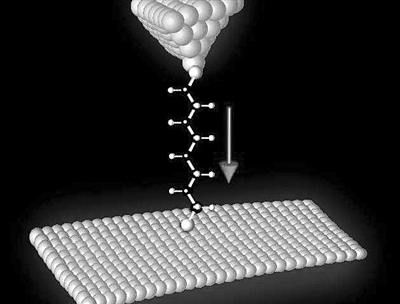According to the physicist organization network recently reported, the international research team led by the University of Michigan in the United States for the first time measured the heat transfer rate through a single molecule, an important step towards the manufacture of molecular computers. Molecular computing uses molecules instead of silicon to create circuits that maximize Moore's Law and make it possible to build the most powerful traditional computers.

The figure shows the heat passing through a single molecule (a chain of carbon atoms bridging the room temperature electrode and the atomic tip of the heating electrode tip). Image source: Physicists Organization Network
Moore's Law states that the number of transistors in an integrated circuit doubles every two years, and it is now believed that Moore's Law has been "reduced". It is generally believed that molecular computing is the "terminator" of Moore's Law, but the development of molecular computers still faces many obstacles, and heat transfer is one of them. Heat transfer refers to the transfer of energy due to temperature differences. According to the second law of thermodynamics, when there is a temperature difference, heat must be transferred from a high temperature to a low temperature.
Edgar Mayhofer, a professor of mechanical engineering, said: "Heat is an important issue in molecular computing because electronic components are basically strings of atoms connecting two electrodes. When the molecule gets hot, the atoms will vibrate quickly, causing The atom string is broken. "
But so far, scientists have been unable to measure the heat transfer along these molecules, let alone control them. In the latest study, the researchers conducted the first experiment to observe the velocity of heat flowing through the molecular chain.
For nearly ten years, the Mayhofer team has been preparing for this. They developed a calorimeter, which has excellent thermal sensitivity, they heated the calorimeter to 20 ℃ -40 ℃. The calorimeter is equipped with a gold electrode with a nano-sized tip; in addition, Korean scientists have prepared a room temperature gold electrode with a molecular coating (carbon atom chain).
They put the two electrodes together until they just touched, which allowed some atoms in the chain of carbon atoms to attach to the electrodes of the calorimeter. With the electrodes in contact, heat flows freely from the calorimeter, and then the researchers slowly pull the electrodes away so that only the chain of carbon atoms can connect them.
They conducted heat flow experiments with a carbon chain of 2-10 atoms long, but the length of the chain does not seem to affect the rate of heat passing through it. At room temperature, the heat transfer rate is 1 ° C per phase difference between the calorimeter and the electrode, and the heat transfer is about 20 picowatts (20 trillionths of a watt).
Theoretical predictions show that even if the molecular chain becomes longer, with a length of 100 nanometers or more, this is also the case for heat transfer at the nanoscale. The team hopes to clarify whether this is the case. (Reporter Liu Xia)
| For products reference | ||
| No. | Item | Description |
| 1 | Bearing Bar Size | 25x3, 25x4, 25x4.5, 25x5, 30x3, 30x4, 30x4.5, 30x5, 32x5, 40x5, 50x5, 65x5, 75x6, 75x10---100x10mm etc. |
| I bar: 25x5x3, 30x5x3, 32x5x3, 40x5x3 etcUS standard: 1''x3/16'', 1 1/4''x3/16'', 1 1/2''x3/16'', 1''x1/4'', 1 1/4''x1/4'', 1 1/2''x1/4'', 1''x1/8'', 1 1/4''x1/8'', 1 1/2''x1/8'' etc. | ||
| 2 | Bearing Bar Pitch | 12.5, 15, 20, 23.85, 25, 30, 30.16, 31, 32.5, 34.3, 35, 38.1, 40, 41.25, 60, 80mm etc. |
| US standard: 19-w-4, 15-w-4, 11-w-4, 19-w-2, 15-w-2 etc. | ||
| 3 | Cross Bar Size and Pitch | Twisted bars 5x5, 6x6, 8x8mm; Round bars Dia.6, 7, 8, 9, 10, 12mm and so on. |
| 38.1, 40, 50, 60, 76, 80, 100, 101.6, 120, 135mm, 2'' & 4'' etc. | ||
| 4 | Material Grade | ASTM A36, A1011, A569, Q235, S275JR, SS400, Mild steel & Low carbon steel, etc. |
| Stainless steel SS304, SS316.s335jr | ||
| 5 | Surface Treatment | Black, self colour, hot dip galvanized, painted, powder coating, electrolytic polishing. |
| 6 | Grating Style | Plain / Smooth, Serrated /teeth, I bar, serrated I bar. |
| 7 | Standard | China: YB/T 4001.1-2007, USA: ANSI/NAAMM(MBG531-88),UK: BS4592-1987, Australia: AS1657-1985,Germany: DIN24537-1-2006, Japan: JIS. |
| 8 | Panel Size: | 3x20ft,3x24ft,3x30ft,5800x1000, 6000x1000, 6096x1000,6400x1000, as request |
| 9 | Application: | oil refinery,petroleum and chemical Industry, Seaport and airport, power plant, transportation, papermaking, medicine, steel and iron, food, municipality, real estate, manufacturing,metallurgy,railway,boiler,etc |
Steel Grating,Steel Bar Grating,Galvanized Steel Bar Grating,Steel Bar Grating For Bridge
HEBEI KAYI BUILDING MATERIAL TECHNOLOGY CO.,LTD , http://www.kayigrating.com